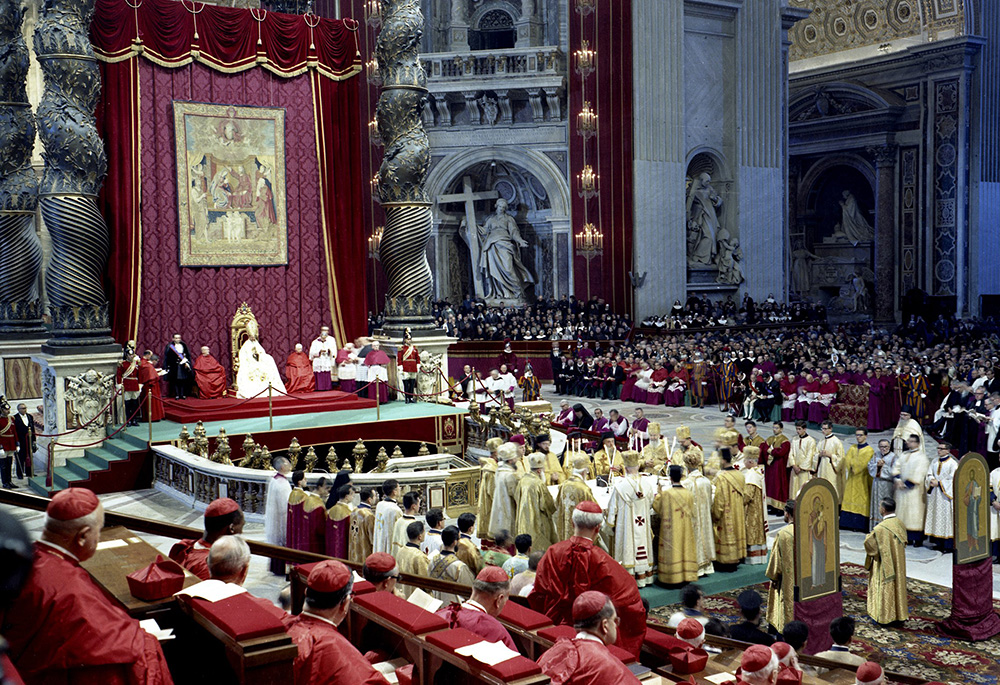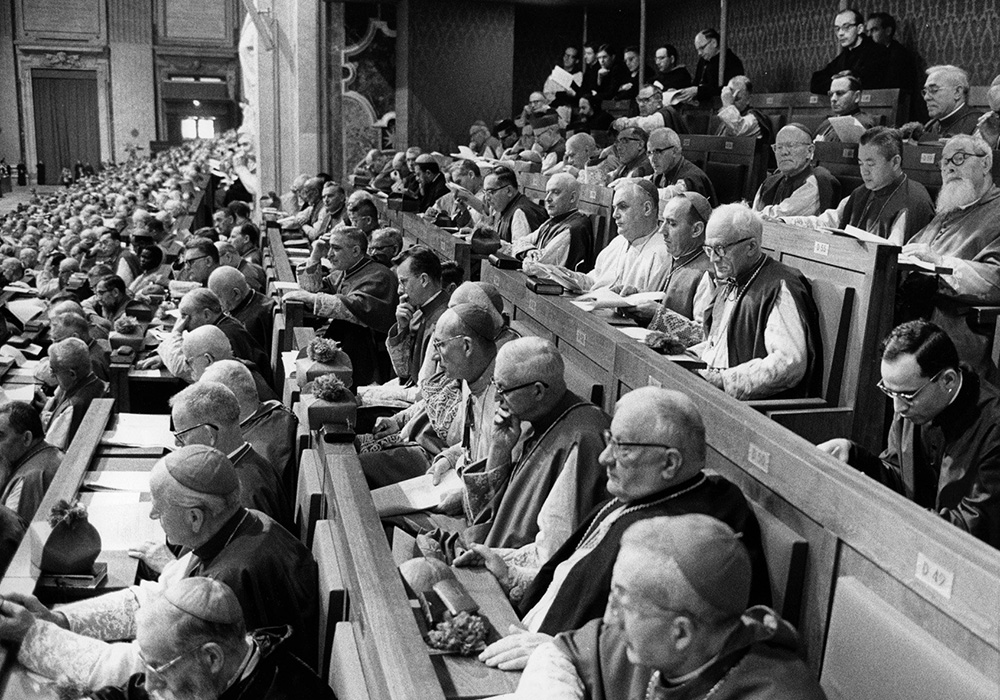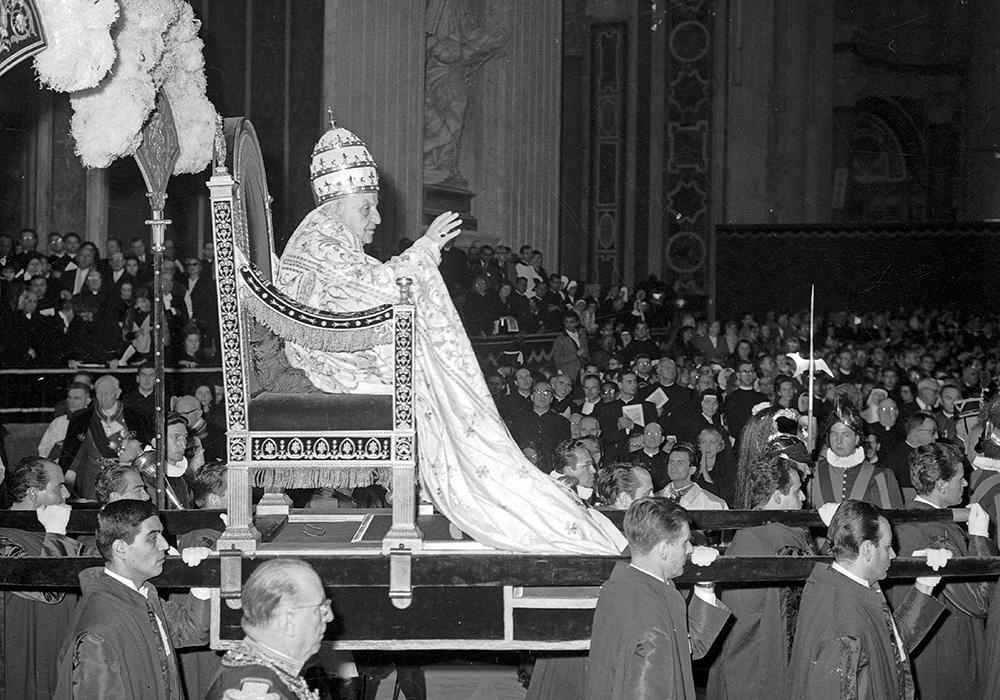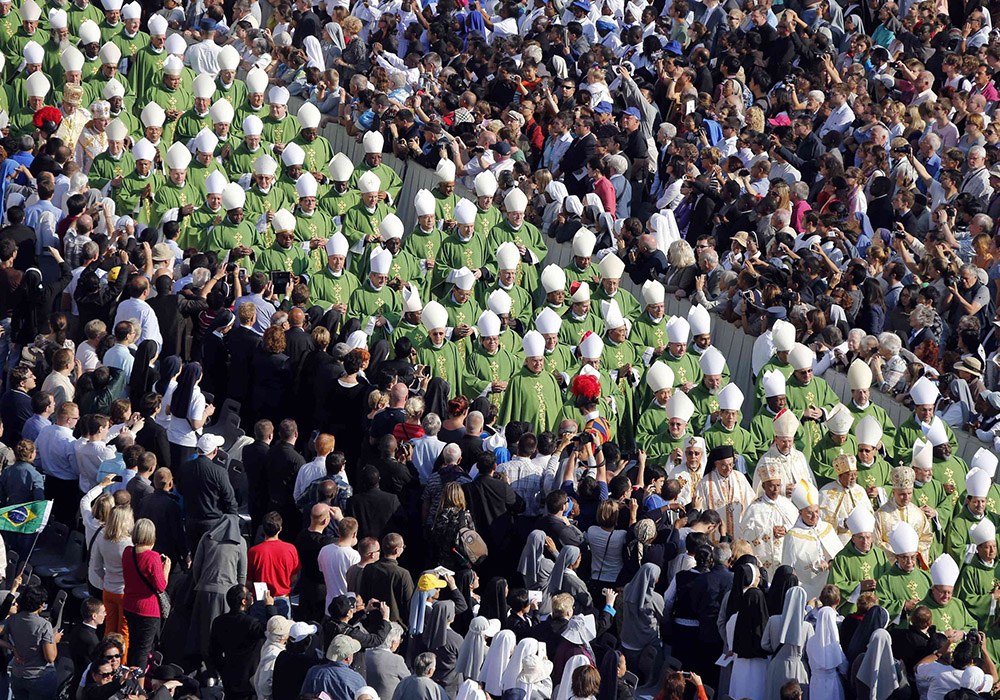
Pope Paul VI presides over a meeting of the Second Vatican Council in St. Peter's Basilica at the Vatican in 1963. (CNS/Catholic Press photo)
Last Friday, I began a review of the new Oxford Handbook of Vatican II, edited by Massimo Faggioli and Catherine Clifford, focusing exclusively on the opening section of the book, which serves as a kind of frame for understanding Vatican II. Today we focus first on the painting in the frame, the event that was the council and the texts that it produced, followed by a brief examination of the handbook's thorough treatment of the reception of the council.
If the first section warranted a more detailed examination of each chapter, for the book's second section, "The Council Documents," it is enough to mention the highlights. Unsurprisingly, Richard Gaillardetz's chapter on the ecclesiology of Vatican II is exceedingly well done. He sets forth some of the important antecedent documents and events that made "the freshness of Vatican II's deliberations and principal teachings" possible. He relates the prior conciliar discussion of the liturgy to the resulting liturgico-sacramental foundation of the ecclesiology found in Lumen Gentium as well as the missionary nature of the church, which would become so central a theme in the post-conciliar landscape. Anyone familiar with Gaillardetz's work on authority will find it set forth concisely here, and how these developments were made possible by the retrieval of a theology of the local church from the ressourcement theologians.
Gaillardetz also helpfully highlights the Trinitarian origins of the church. The Christocentrism of the documents of Vatican II is evident, but not exclusive. "As Congar observed, the council's ecclesial Christocentrism escapes a more reductive Christomonism by integrating the missions of Christ with that of the Spirit," Gaillardetz writes. "Together, Christ and the Spirit 'co-institute' the Church." I have read a lot about ecclesiology but have never before encountered such a clear articulation of the pneumatology at work in the texts.
The chapter on revelation, from Australian Jesuit Gerald O'Collins, is similarly masterful. I count less than a dozen paragraphs in the entire chapter that are not underlined, asterisked or dog-eared in my copy. These two sentences strike precisely the kind of thoughtful, balanced treatment characterizes the whole: "In worship and life, revelation continues as an actual encounter with God. But this living dialogue adds nothing to the core of the divinely revealed truths, which essentially amount to Jesus Christ crucified and raised from the dead, along with the coming of the Spirit."

Between 2,000 and 2,500 bishops attended each Vatican II session inside St. Peter's Basilica. The council produced 16 landmark documents that transformed the church. (CNS file photo)
Boston College theologian Jane Regan's chapter on faith formation is similarly compelling although I thought her treatment of the issue of Christian anthropology lacked a substantive discussion of Gaudium et Spes 22, which was so central to the theology of Pope John Paul II and his many teaching documents. That said, her treatment of the relationship of catechesis and evangelization is excellent and should become mandatory reading for those who confuse the two or, even worse, mistake apologetics for evangelization.
The chapter on religious liberty, by Italian theologian Silvia Scatena, offers a thorough discussion of the machinations at the council that led to the adoption of Dignitatis Humanae, but suffers from a too easy adoption of the perspectives of Jesuit theologian John Courtney Murray. Her opening sentence — "Intended as a personal and collective right to immunity from coercion and restriction in the practice and diffusion of one's beliefs ..." — evidences Murray's acceptance of a negative conception of liberty, or freedom from. As Scatena herself documents in this chapter, other theologians saw the danger here and insisted that a positive conception of liberty be highlighted, a freedom for, in this case, the pursuit of truth. At an important ecumenical conference sponsored held at the University of Notre Dame in 1966, the proceedings of which are published, Murray was asked about this difference between negative and positive conceptions of liberty and admitted that they had "skated around" the issue in the final text.
The chapter on Gaudium et Spes exhibits frequent exaggeration, for example, this claim: "For 1,500 years, the Church failed to overcome its disdain for the world." That is a bit simplistic, for example, in the High Middle Ages, the church had accepted responsibility for the whole of culture and Leo XIII urged the French church to rally to the Third Republic in the 1890s, important counterexamples to the claim that disdain was normative.
On the other hand, the chapters on liturgy, missiology and ecumenism were magnificent. There is also a fascinating chapter by Italian historian Alberto Melloni on the "expunged and forgotten texts and messages of Vatican II," such as the "Message to the World," which the council fathers adopted shortly after gathering in Rome in 1962 and the seven closing statements to world leaders, women, workers, young people, etc., issued at the close of the council in 1965, all of which I had completely forgotten about. His treatment of Pope John XXIII's opening address, Gaudet Mater Ecclesia, and the effect it had on the assembled bishops, is masterful.

Pope John XXIII leads the opening session of the Second Vatican Council in St. Peter's Basilica Oct. 11, 1962. (CNS/L'Osservatore Romano)
The next section of the book shifts to the complex issues of receiving the council and it opens with a chapter on the theology of reception from Laval University's Gilles Routhier. If you could only read one chapter in this volume, I would recommend Routhier's. He makes an argument that, once it is made, seems self-evident but that I have never read before, namely, that the council was itself an act of reception, "reception of Scripture, reception of the creed, reception of the teachings of previous councils, reception of magisterial teachings, reception of the customs and traditions that make up the heritage of the different churches within their cultural context, and so on." Of course, that is correct, and it takes much of the wind out of the sails of those who reduce arguments about proper hermeneutics to bumper sticker slogans.
Routhier's essay also does something else that happens too infrequently in contemporary theology: At the end of his essay, you find your faith has been strengthened, not merely illuminated. For example, he writes, "The Church is therefore a community of reception of the gift of God. … Before speaking about the reception of a council, one must think of the Church as a place where God's gifts are welcomed and received, and one must draw attention to the fact that this people is constituted by an act of tradition and reception."
He makes an argument that, once it is made, seems self-evident but that I have never read before, namely, that the council was itself an act of reception.
Here is the beginning of an answer to the problem posed at last year's gathering of bishops, church leaders and theologians at Loyola University Chicago: We live in a culture of grievance but we possess a theology of grace and gratitude. How to connect the two?
Philippe Roy-Lysencourt, who teaches the history of Christianity at Laval University, has an excellent essay on the way traditionalist Catholics did — and did not — receive the council, and Salvador Pié-Ninot, who teaches at the Gregorian University and the Catalonian theological faculty in Barcelona, ably summarizes the periods of the reception of the council so far, with a balanced treatment of key events from the 1985 Synod of Bishops on the subject to Pope Benedict's famous 2005 address to the Curia on the hermeneutic of reform.
Subsequent chapters examine the council and the papacy, the reception of Vatican II in systematic, moral and feminist theology, and a very enlightening chapter on the reception of Vatican II in canon law by Catholic University of America's John Beal. Beal discusses one of the real failures of the reform of Vatican II, the decision not to include administrative law provisions in the new code. "Excised from the revised Code during the last edits by Pope John Paul II were norms structuring the administrative tribunals." Instead, the code contains "norms [which] largely reproduce the long-standing praxis Curiae Romanae for dealing with recourses against the decrees of hierarchical authorities." This flaw continues to haunt the church as it grapples with issues surrounding the termination of lay employees.
Advertisement
The fourth section of this large volume examines the reception of Vatican II by other Christians and by non-Christians. It would never have occurred to me to include the effects of Vatican II on non-Catholics under the rubric of "reception" but these chapters fascinate and prove the value of this framing. These chapters look at the role of the non-Catholic observers at Vatican II, who were surprisingly influential, especially on the decrees on ecumenism, on relations with non-Christian religions and on religious liberty. And they examine the post-conciliar dialogues that were established.
Sometimes, outsiders see things more clearly than those of us on the inside, and that is the case with these chapters. British Methodist David Carter, formerly a religious studies lecturer at Open University, writes, citing U.S. Methodist and council observer Albert Outler, "The notion of the Church as mystery was fundamental. It lifted the discussion above the level of the instrumental. It established that 'we belong to the Church, not the Church to us.' " That is beautifully said.
Canadian evangelical theologian Tim Perry's chapter on evangelical reception of Vatican II — he argues there was not much — is especially important for understanding the role of religion in public life in the U.S., showing how and why the unlikely alliance between conservative Catholics and evangelicals emerged. The chapters on relations with Jews and other non-Christian religions are all exceedingly well done and enlightening.
The final section contains chapters examining the reception of Vatican II by geographic region: In Asia, Africa, North America, etc. I am not in a position to evaluate these. Marymount University's Brian Flanagan examined the reception of Vatican II in the U.S. and Canada and his treatment is fine if pedestrian. He notes that the postwar shift of Catholic populations to the suburbs, where they intermingled with non-Catholics in a way they had not done previously. But you have to flip back to Faggioli's essay to see the deeper effects that intermingling produced, namely, "religion ceased to be associated primarily with specific denominations and denominational creeds and came to be associated with broad ethical and political trends along 'liberal' and 'conservative' political lines." On the other hand, Flanagan's discussion of the fallout over Humanae Vitae is well calibrated and makes up for the lack of any consideration of that fateful encyclical in the already mentioned chapter by Pié-Ninot on the reception of Vatican II. The chapter on Latin America and the Caribbean by Chilean theologian Carlos Schickendantz also warrants a shout-out for its fine balancing of theological and popular movements in the post-conciliar church.

Bishops walk in procession before Pope Benedict XVI celebrates Mass in St. Peter's Square at the Vatican Oct. 11, 2012, to mark the 50th anniversary of the opening of the Second Vatican Council. The Mass also opened the Year of Faith. (CNS/Reuters/Stefano Rellandini)
I would expect there to be a fair number of factual mistakes in a book of this length — it is 777 pages long — and with so many authors, many of whose chapters had to be translated. I found only a few. The otherwise excellent chapter on the Orthodox Church's reception of Vatican II refers to a "fifth session" and there were only four sessions. John Borelli, in his fine chapter on interreligious dialogue, writes, "In November 1963, towards the end of the third session …" but the second session was in 1963, not the third. These are small potatoes and, as I say, in a book of this size and range, the fact that there are so few such small mistakes, typos really, is a remarkable testimony to the editors' carefulness.
This volume comes at a time when the significance of Vatican II is being recalibrated. As I have written before, many U.S. academic theologians have been overly focused on issues of gender and ethnography, and more generally have uncritically adopted the social sciences as not just a lens but the lens through which they examine ethical and ecclesial issues. There is a blessed absence of "the now dominant preferential option for the exotic, which is something very different from the legitimate emphasis on diversity and inclusion, and an awareness of the multiplicity and plurality of Christian and Catholic traditions" diagnosed by Faggioli in a recent article at The Lamp.
This book reminds us that Vatican II's focus was quite different and invites anyone who wants to seriously engage ecclesial life to refresh and recalibrate their intellectual bearings. For those who know little of the council, the book is the perfect primer. For those called to preach or teach in the name of the church, it becomes an invaluable guide, from university professors to parish priests to catechists.
Friday, I called this book "a Hydra" and it is many-headed indeed. But Hydra was a monster and a myth, and this book is neither. It is engaging, learned and largely accessible. The thinking is careful, as it should be, based on expertise not whim or fancy. It should be found in every theology faculty members' library and on the shelf of every minister. It is an astonishing achievement.








